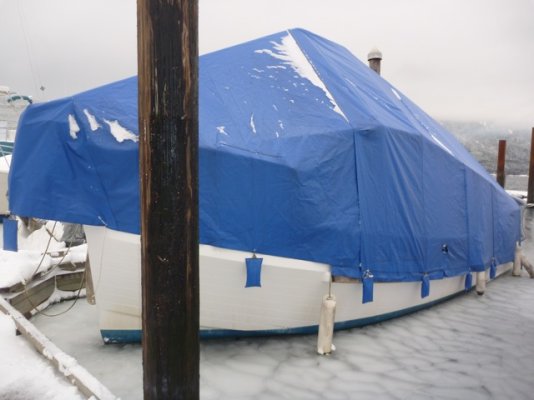MurrayM
Guru
Hi there,
This is our first winter with our boat. I was wondering what kind of engine compartment temperatures people in other cold regions were seeing, what minimum temperatures they had to contend with, and what they did to hold the cold at bay.
Our boat is fully covered by a heavy snow shedding tarp so heat loss from wind isn't really an issue, and sits in brackish water that is freezing in quiet areas of the marina near shore. There are two 60 watt bulbs in the galley area, and a flat marine heater giving constant low warmth in the main berth forward. According to the son of the previous owner, this is all it has ever needed for the last 20 years, and says it has never dropped below freezing in the engine compartment. This seems pretty spartan, but 20 years of success is hard to argue with. It can drop to -20C (-4F) in this area for a couple weeks at a time.
Last week when it was -8C (17.5F) I measured the temperature in the engine compartment, which had no heat at all, and it was 3.5C (38F). Yesterday I put a 60 watt light down there with a metal bullet reflector, and pointed it towards a plastic stool to absorb and radiate the heat. This morning it was colder at -10C (14F) and the engine compartment had gone up to 4.5C (40F).
I've seen some whiz-bang fancy heaters that turn on at 35F and shut off at 45F, so this puts us right in the ballpark...so far...
What do you other cold weather folks do?
Murray
This is our first winter with our boat. I was wondering what kind of engine compartment temperatures people in other cold regions were seeing, what minimum temperatures they had to contend with, and what they did to hold the cold at bay.
Our boat is fully covered by a heavy snow shedding tarp so heat loss from wind isn't really an issue, and sits in brackish water that is freezing in quiet areas of the marina near shore. There are two 60 watt bulbs in the galley area, and a flat marine heater giving constant low warmth in the main berth forward. According to the son of the previous owner, this is all it has ever needed for the last 20 years, and says it has never dropped below freezing in the engine compartment. This seems pretty spartan, but 20 years of success is hard to argue with. It can drop to -20C (-4F) in this area for a couple weeks at a time.
Last week when it was -8C (17.5F) I measured the temperature in the engine compartment, which had no heat at all, and it was 3.5C (38F). Yesterday I put a 60 watt light down there with a metal bullet reflector, and pointed it towards a plastic stool to absorb and radiate the heat. This morning it was colder at -10C (14F) and the engine compartment had gone up to 4.5C (40F).
I've seen some whiz-bang fancy heaters that turn on at 35F and shut off at 45F, so this puts us right in the ballpark...so far...
What do you other cold weather folks do?
Murray
Last edited:

